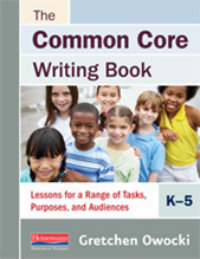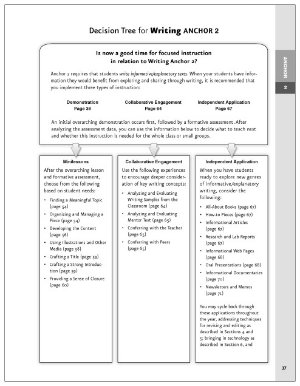A Common Core Writing Book That Understands Teacher Needs
The Common Core Writing Book: Lessons for a Range of Tasks, Purposes, and Audiences
By Gretchen Owocki
(Heinemann, 2013 – Learn more)

The shelves of professional libraries are sagging with resources on the Common Core Standards, but there are few that meet the standard set by Gretchen Owocki’s new book, The Common Core Writing Book: Lessons for a Range of Tasks, Purposes, and Audiences. Her book has practical strategies for each of the standards, as well as strategies for ELL students and students who need reinforcement.
“…we are teaching in an era in which research evidence has confirmed that the teaching – not the program – is the most important variable affecting student achievement (Cunningham and Allington 2011).” (p. xvi)

Owocki’s book does not take umbrage at the new Common Core Standards, but shows how the standards can bring out the best in our students. “As we shape the new system and work within it, we must take care to not lose sight of meaningful teaching and learning.” (Owocki, p. xvi)
Well organized and easy to use
This fantastic spiral bound book is organized into ten sections, one for each anchor standard. Embedded in each section is the “Decision Tree”, a graphic organizer divided into three sections: Mini-lessons, Collaborative Engagement, and Independent Application. The “Decision Tree” provides a quick view into how to differentiate the lessons to meet the needs of the students. (Click to see larger image.)
I was able to use and apply Ms. Owocki’s strategies during a recent reading unit of study, Nonfiction Writing with a Lens on Science. Each section, strategy and “words of wisdom” helped my teaching become more powerful and meaningful for my students. A concise K-5 grid of Anchor 2 Standard (Writing informative/explanatory texts), helped to guide my teaching of the unit.
As an upper elementary teacher (grade 4), I was able to analyze the scaffolding of the standard to see how it fit in the continuum of learning. Her book is unlike other writing resources. The graphic organizers and material are easily adaptable to a district’s curriculum. At the same time, this is not a scripted manual but a manual that recognizes effective teaching and teachers.
So Many Timesavers!
What do teachers have a lack of? Time! This book is full of timesavers to use immediately. As educators, we know how critical it is to observe and collect data to improve and fine tune our teaching practices. Ms. Owocki makes this task easier for the teacher by providing a standards-based, class record-keeping guide, specific to each grade level. At a glance, you are able to formatively assess your students and determine their needs (great for differentiating instruction or for table conferences).
Searching for mentor texts to model lessons can also be time consuming. The author saves the teacher from being lost in the myriad of Internet links, trying to decide which mentor texts to use, by providing a sample list of mentor texts for each grade level with a short summary of each text.
Release of Responsibility that Really Works
As I skimmed the book for strategies to use with future genres, I felt as if each page was a birthday present. Each idea seemed to be written “just for me.” Each chart seemed to be written “just for me.” Each mini-lesson seemed to be written “just for me.” I admired the author for making sure that the gradual release of responsibility was provided in each lesson and that the rigor that is present is valid and valuable. Students are expected to take charge of their own learning, “Children can be very capable and responsible responders to their peers’ writing, especially when they are given some starting expectations for the conversations.” (p.149)
A warning label should come with The Common Core Writing Book: “Be careful. Reading and using this book can be addicting to you and good for your students.” If you want a book that will reaffirm your thoughts about teaching writing, this book is for you. If you want a book that you can use tomorrow, this book is for you. If you want a book that will guide you through the new Common Core Standards without anxiety and trepidation, this book is for you. If you want a book that will help raise the rigor of your teaching, this book is for you.
This book will be traveling with me to and from school (or maybe I might get an extra copy to keep at home).
Linda Biondi is a fourth grade teacher at Pond Road Middle School in Robbinsville, NJ, and a recipient of several educational grants that infuse a literacy enriched curriculum with an understanding of individual learning styles to help students understand bias and patterns of discrimination. She is a Teacher Consultant with the National Writing Project and a participant on the NJ Department of Education Teacher Advisory Panel.





































